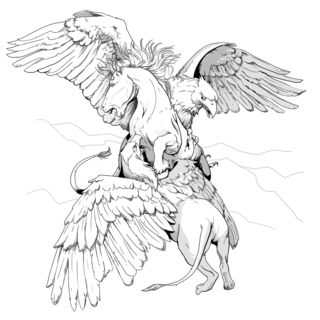
In the Dungeons & Dragons fantasy role-playing game, the manticore is a legendary creature with the body of a lion, dragon wings, and humanoid head. It is based on the mythological manticore.

In the Dungeons & Dragons fantasy role-playing game, nagas comprise a variety of similar species of intelligent aberrations with widely differing abilities and alignments.

In the Dungeons & Dragons fantasy role-playing game, the roc is a gargantuan, eagle-like animal, based on an earlier creature from myth and fantasy also named the Roc.
In the Dungeons and Dragons fantasy role-playing game, the grick is an aberration. A grick resembles a large, darkly colored worm or snake-like creature. Its beak is ringed by four barbed tentacles, which are its main weapons.

In the Dungeons & Dragons fantasy roleplaying game the will-o'-wisp is a malevolent entity which makes its home in swamps and bogs. This aberration consists of a bizarre, spongy substance which hovers through telekinesis in the air, enveloped in a mysterious glow of yellow, white, green or blue.
In the Dungeons & Dragons fantasy roleplaying game, the skum is a fish-like aberration.

In the Dungeons & Dragons fantasy role-playing game, the stirge is a mosquito-like magical beast and a classic D&D monster.

In the Dungeons & Dragons fantasy role-playing game, a girallon is a magical beast.

In the Dungeons & Dragons fantasy roleplaying game, the griffon is a powerful, majestic and fierce magical beast.
The shocker lizard is a magical beast in the Dungeons & Dragons fantasy role-playing game.
In the Dungeons & Dragons fantasy role-playing game, the gray render is a magical beast born from various terran substances present in swamps and marshes.
The yrthak is a fictional magical beast in the Dungeons & Dragons fantasy role-playing game, that can be described as somewhat akin to a reptilian bat.
In the Dungeons and Dragons fantasy role-playing game, the belker is an elemental creature with a body composed mainly of smoke from the Elemental Plane of air.

In the Dungeons & Dragons fantasy role-playing game, the yeth hound is a sinister flying canine inhabiting evil aligned planes. Long and skinny, it is described as resembling as a dog crossed with a lynx, and is deep black in color with yellow eyes. Although lacking wings, the creature is inexplicably capable of flight. Within the game, packs of yeth hounds only hunt during the night and never venture out during the day. If abroad during the day, the sunlight causes them to quickly fade away to the ethereal plane where they cannot return. Yeth hounds understand the language "Infernal", but cannot speak.
In the Dungeons & Dragons fantasy role-playing game, the lillend is a benevolent half-snake outsider; a being from another plane.

The remorhaz is a magical beast in the Dungeons & Dragons fantasy role-playing game. It is similar to another monster in the game, called the frost worm.
A krenshar is a strange catlike carnivore from Dungeons & Dragons and the Pathfinder Roleplaying Game.
The Dungeons & Dragons fantasy role-playing game contains many plant creatures that are composed of vegetable material, but unlike normal plants these monsters may be carnivorous, intelligent, mobile, or any combination of the three. In the 3rd edition of Dungeons & Dragons, plant creatures have the plant "creature type".












